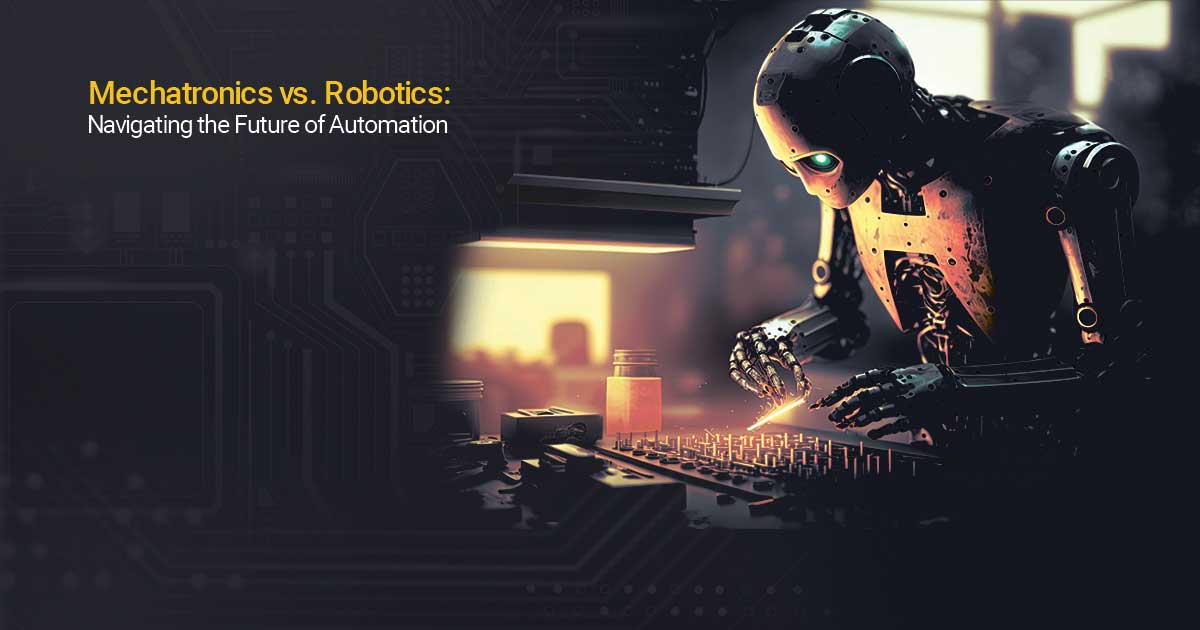FET Blogs


FET Blogs



20 November 2023
The future of mechatronics and robotics in India and around the world appears promising and dynamic. The potential of both these domains is propelled by rapid technological advancements, a constant need for automation, and the call for innovative solutions across various sectors. As manufacturing and production processes become progressively automated, the demand for skilled professionals in industries such as automotive, electronics, and pharmaceuticals is set to continually expand. Recent emphasis by a defense council has underscored the critical role of mechatronics and robotics in India and globally, particularly in operating unmanned aerial vehicles (UAVs), bomb disposal robots, and surveillance drones for both national and international security.
While the term 'robotics' is familiar to many, 'mechatronics' might be less well-known. Mechatronics is an emerging engineering discipline that is gaining traction in response to the growing automation of tasks previously carried out by humans. This engineering discipline focuses on the principles behind creating and producing automated machinery. Robotics is often considered a subset of mechatronics engineering; however, these two are considered separate disciplines in general. Let us delve further into these two engineering fields and understand which is a better career in automation:
The undergraduate (UG) courses offered in mechatronics are a Bachelor of Engineering (B.E) and a Bachelor of Technology (B.Tech) in mechatronics. These two specialised UG programmes have a duration of 4 years, divided into 8 semesters. As far as post-graduation (PG) is concerned, students can pursue a Master of Engineering (M.E) and a Master of Technology (M.Tech) in mechatronics. The duration of these PG courses encompasses 2 years, split into 4 semesters. Besides these courses, there are other 1-year diploma courses in mechatronics in India, including automation systems, CAD/CAM, and electrical systems.
Robotics, on the other hand, offers UG courses such as B.E and B.Tech in robotics, respectively, each entailing a duration of 4 years and 8 semesters. Additionally, students can also pursue a Master degree in a relevant field, which consists of a duration of 2 years, divided into 4 semesters. There are other diploma courses in the field of robotics, encompassing a duration of one year. The specialisations offered by these diploma courses include industrial robotics, mobile robotics, and medical robotics.
Admissions to UG mechatronics and robotics programmes are determined after attaining the benchmark score from either of the entrance examinations and merit lists. Entrance exams such as Joint Entrance Examinations (JEE) (Main and Advanced) and JoSAA Counselling are administered to secure admission to IITs, NITs, IIITs, and GFTIs. State-level entrance exams are organised for admission to government engineering colleges or universities at the state level. To gain entry into private engineering courses, students can utilise state-level entrance exams, direct admission, or management quota options. For admission to deemed universities, either JEE Main or university-level entrance exams are conducted. Furthermore, students must have completed their Class XII education at a school affiliated with a recognised board and obtained a minimum of 50% marks in the science stream.
Mechatronics is a multi-disciplinary domain that combines aspects of mechanical engineering, electronics, and computer science. This engineering field focuses on blending mechanical and electronic systems to produce intelligent and automated products and procedures. Students learn about different topics such as mechanical design, electronics and circuits, microcontroller programming, and control systems. To bridge theory with practice, mechatronics programmes often emphasise internships and practical training. These internships provide students with valuable hands-on experience in real-world engineering settings. Practical training may encompass working with industrial automation systems, electronic components, and integrated control systems.
Conversely, robotics is a specialised branch of mechatronics that primarily focuses on the design, construction, and programming of robots. While robotics is a part of mechatronics, it has a more specific focus on creating robotic systems. The curriculum of a robotics course covers topics such as robot kinematics, dynamics, sensor integration, and robot programming. Students often engage in internships or cooperative experiences with companies or research institutions specialising in robotics. These opportunities expose students to the intricacies of robotic design and operation, and they may involve hands-on work with various types of robots, such as industrial robots, autonomous vehicles, or robotic arms.
The growth of industrialisation has led to a notable upsurge in the requirement for mechatronics specialists within a broad spectrum of industries. As sectors like automotive, aerospace, consumer electronics, and healthcare consistently expand and embrace automation, employers will perpetually seek out mechatronics professionals. With the growing focus on automation and robotics in manufacturing and logistics, there will be an increased demand for mechatronics engineers capable of developing and deploying automated systems and robots. A career in mechatronics offers abundant job opportunities across various sectors. Upon graduation, students can explore careers as mechatronics engineers, where they design, develop, and maintain complex automated systems, manufacturing processes, and robotic applications. Other roles include control systems engineering, specialising in the creation and management of integrated control systems that regulate machinery and processes. As the Internet of Things (IoT) gains prominence, there is a growing need for mechatronics experts to engage in IoT development, integrating sensors and data analytics into smart devices and industrial applications.
Conversely, the field of robotics also presents substantial career prospects, with a multitude of job openings spanning various industries. With the expanding utilisation of automation and intelligent systems in fields as diverse as manufacturing, healthcare, logistics, and space exploration, the demand for robotics professionals is on a continuous upswing. Robotic engineers and specialists design, build, and programme robotic systems, whether for industrial automation, autonomous vehicles, or medical applications. Upon graduation, students can advance their career as robotics software engineers, responsible for developing the software and algorithms that control and coordinate robotic systems. Another interesting career avenue is that of an autonomous vehicle engineer, designing self-driving vehicles and related technologies, such as sensors and computer vision systems. Students can also pursue a career as robotic process automation (RPA) developers, responsible for creating automated software bots that mimic human actions. Lastly, students can also become human-robot interaction (HRI) designers, developing user-friendly interfaces and interactions between humans and robots in applications like customer service or healthcare.
The oscillating demand for automation and innovative solutions has elevated mechatronics and robotics as appealing career pathways in India and abroad. Mechatronics, a rising discipline, combines mechanical, electronic, and computer engineering, offering multidisciplinary expertise. Meanwhile, robotics focuses on designing, building, and programming robotic systems for various applications. As students explore these fields, they can expect diverse and engaging career opportunities across industries like aerospace, healthcare, and others. The students’ expertise in developing and maintaining automated systems and robotic applications is indispensable in today’s evolving landscape. Therefore, students should align their areas of interest and explore careers in robotics software engineering, autonomous vehicle engineering, and various other disciplines.
A1: Mechatronics or robotics engineering is best for robotics careers.
A2: Robotics automation will expand in manufacturing, healthcare, and smart cities.
A3: Cognitive automation, using AI, is the most advanced automation type.
A4: Mechatronics engineering is closest to robotics, blending multiple disciplines.
A5: Japan leads in robotics and automation due to innovation and adoption.
Popular Post
16 January 2026
What is Aerospace Engineering?
16 January 2026
What is Chemical Engineering?
12 January 2026
Best Engineering Courses in India: Top 10 Courses, List, Types & High-Salary Options
07 January 2026
What is Mechanical Engineering?
Ask an Expert for Free